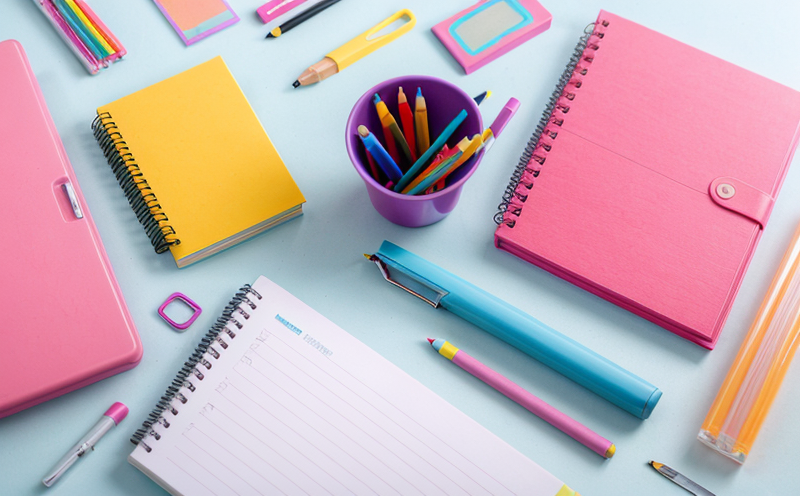Weathering Testing of Outdoor School Materials
The weathering testing of outdoor school materials is a critical component in ensuring product safety and durability, especially for items used directly outdoors. As consumer products and stationery are subjected to various environmental conditions such as sunlight, rain, humidity, temperature fluctuations, and pollution, their performance can degrade over time. This degradation can pose risks not only to the longevity of the product but also to user health and well-being.
Outdoor school materials include items like chalkboards, whiteboards, playground equipment, outdoor learning stations, and other supplies that are exposed to the elements for extended periods. The testing process aims to simulate real-world weathering conditions in a controlled laboratory setting, providing insights into potential aging effects on these materials.
The testing protocol typically involves exposing samples of the material to various environmental factors. For instance, exposure to UV light is crucial as it mimics the effects of sunlight which can cause fading and cracking. Additionally, moisture cycling tests are conducted to simulate the alternating wetting and drying conditions that outdoor items often experience.
Testing methods follow internationally recognized standards such as ASTM G154, ISO 4892-3, and EN 927-6, which specify procedures for evaluating weathering resistance. The choice of test method depends on the specific type of material being tested; for example, chalkboards may be evaluated under different conditions than playground equipment.
In addition to physical property changes like color fading or surface degradation, chemical tests are also conducted to assess leachates from materials that come into contact with children. These tests help ensure that even after prolonged exposure to the elements, the products remain safe for use by students and teachers.
- ASTM G154: Standard Practice for Operating Solar Simulation Apparatus
- ISO 4892-3: Plastics – Part 3: Weathering Test Methods
- EN 927-6: Safety of playground equipment for children – Part 6: Environmental factors
The importance of this testing cannot be overstated. It helps manufacturers identify potential weaknesses in their products early on, allowing them to make necessary adjustments before products reach the market. Compliance with these standards also ensures that schools and educational institutions can trust the materials they purchase will withstand environmental challenges effectively.
Why It Matters
The durability and safety of outdoor school materials directly impact both the longevity of these resources and the health and safety of those who use them. For instance, chalkboards that fade or crack due to weathering can become difficult for teachers to read clearly, potentially affecting classroom dynamics. Similarly, playground equipment that fails under stress from weather conditions could pose serious risks if it breaks during playtime.
From a broader perspective, ensuring high-quality materials supports educational institutions in maintaining their budgets by extending the lifespan of critical assets without compromising safety or functionality. This proactive approach not only saves money but also enhances learning environments by providing reliable tools and equipment.
In line with regulatory requirements, compliance with international standards like those mentioned above is essential for ensuring that products meet necessary safety thresholds. By adhering to these guidelines, manufacturers contribute to the overall improvement of educational facilities around the world.
Benefits
Conducting weathering tests on outdoor school materials offers numerous advantages beyond mere compliance with regulations:
- Informed Decision-Making: Test results provide valuable data that informs product development and improvement strategies, helping manufacturers create more robust and safer products.
- Enhanced Reputation: Demonstrating a commitment to quality through rigorous testing enhances the reputation of both educational institutions and suppliers involved in procurement processes.
- Cost Savings: By identifying issues early on, extensive repairs or replacements later can be avoided, leading to significant cost savings over time.
- Safety Assurance: Ensuring that all materials used outdoors are safe and durable protects users from potential hazards such as structural failure or material toxicity.
Quality and Reliability Assurance
To ensure consistent quality and reliability, our laboratory adheres strictly to international standards. Here are some key aspects:
- ASTM G154: Ensures that solar simulation apparatus operate correctly for evaluating weathering resistance.
- ISO 4892-3: Provides comprehensive guidelines on various weathering test methods applicable to different types of materials.
- EN 927-6: Focuses specifically on environmental factors affecting playground equipment, ensuring it remains safe and functional under outdoor conditions.
We use state-of-the-art equipment calibrated according to these standards to conduct thorough tests. Our experienced team of engineers and scientists ensures accurate results that can be trusted by all stakeholders involved in the testing process.





